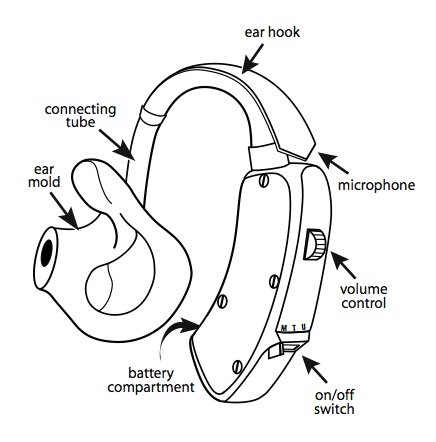HEARING AIDS A hearing aid is a small device worn in or behind the ear. The hearing aid is chosen and designed to amplify sound based upon your child’s hearing loss. The hearing aid provides the greatest amplification at the frequencies (pitches) where your child has the most hearing loss and the least amplification at the frequencies where your child has the least hearing loss. It will be carefully adjusted to keep loud sounds within your child’s comfortable listening range. Hearing aids do not make hearing normal again, but they can help make speech sound clearer and easier to hear. Types of Hearing Aids Finding
the correct type of hearing aid is important. Because language learning begins within the baby's first
months of life, it is important for babies with hearing loss to start
using hearing aids as soon as possible. There are two kinds of hearing
aids usually used for children: Behind-the-ear (BTE) and In-the-ear (ITE). Behind-the-ear
(BTE) hearing aids are most commonly used with young children for a
number of reasons. Children's ears grow rapidly, and with the BTE you
can change the earmold without having to get a new hearing aid. Also,
the earmold is easy to clean and parents can easily check and change
the settings on a BTE.
 |  Parts of a Hearing Aid The three main parts of a hearing aid are the microphone, amplifier, and receiver. The microphone picks up sounds from the environment, converts it to an electrical signal and sends it to the amplifier. The amplifier makes the sound louder. The hearing aid will make some pitches of sound louder than others, depending on the shape of the hearing loss. The receiver transforms the electrical signal back to sounds waves and sends them to the ear. The ear hook is a small plastic piece that holds the hearing aid on the ear. Ear molds are made from an impression of your child's ear. They are soft and fit snuggly into the ear. They will need to be replaced as your baby grows, probably every 2-6 months. They are available in a variety of colors, from skin tone to bright colors. Taking Care of Hearing Aids Proper maintenance and care will extend the life of your hearing aid. Make it a habit to:
|
COCHLEAR IMPLANTSDepending on the nature of your child’s hearing loss and other factors, he or she may be a candidate for receiving a cochlear implant. Your audiologist may have mentioned this device as an option that could help your child hear. Although implantation will not happen until your son or daughter is around 12 months of age, it is never too soon to start being informed about this form of intervention. What is a cochlear implant?
A cochlear implant is exactly what its name sounds like. It is an electronic device that is surgically implanted (or, attached) onto your child’s head and into his or her cochlea, one of the parts of the inner ear. The cochlear implant takes sounds from the environment, changes them into electrical signals, and those electrical signals directly activate the auditory nerve (the nerve that sends sound information to the brain).There are six main parts of a cochlear implant. Four of them are located on the outside of your child’s head: the battery (which powers the device), the microphone (which picks up sounds from the surrounding environment), the processor (which changes those sounds into electrical signals), and the transmitting coil (which rests on your child’s head via a magnet and sends those electrical signals to an internal receiver). The two remaining parts are located beneath the surface or within your child's head: the electrodes (electrical units that activate the auditory nerve, which is the nerve that sends sound information to the brain) and the internal receiver (sends electrical information to those electrodes).
.jpg.opt226x245o0,0s226x245.jpg) |  Image obtained from http://kidshealth.org/parent/general/eyes/images_69950/P_cochlear-noConsole.jpgWho can receive a cochlear implant?Frequent consultations with the audiologist and other members of your child’s ‘team’ will help you in making this decision. But, in general, the following criteria must be met in order for your child to be considered for a cochlear implant:
|
Portions of this information came from: Holmes, A. E. & Rodriguez, G. P. (2007). Cochlear implants and vestibular/tinnitus rehabilitation. In Schow, R. L. & Nerbonne, M. A. Introduction to Audiologic Rehabilitation, 5th edition (pp.77-112). Boston: Pearson.